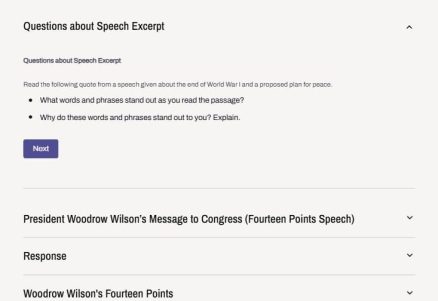
President Woodrow Wilson's Fourteen Points Speech
The Emergence of Modern America (1890-1930)
A National Archives Foundation educational resource using primary sources from the National Archives

Published By:
Historical Era:
Thinking Skill:
Bloom’s Taxonomy:
Grade Level:
This activity can be used during a unit on World War I, U.S. involvement in World War I, and plans to end World War I. For grades grades 6-12. Approximate time needed is 45-60 minutes. Students can complete the activity individually, in pairs, or in small groups.
Open the activity and display the first box – a quote from President Wilson’s 14 Points Speech – without a title or author. Provide context for the quote by stating that the author is talking about the end of World War I and a plan for peace. Read the text aloud, or have a student volunteer do so, so that the class can hear the full excerpt.
As they read, tell students to focus on the following:
After reading the selection, ask students to enter their answer in the blank text box that follows, or to conduct a turn-and-talk with a partner to share their phrase and word selections and explain why they were chosen. Ask students to volunteer their phrase and word selections, with explanations, for the rest of the class. As students share, ask if other students selected the same phrase or word, and facilitate a conversation about the reasons why specific phrases and words were selected.
Click on the next box to reveal the author of the plan and the explanation that, by the end of World War I, Woodrow Wilson was promoting peace and justice, rather than revenge and punishment for the Central Powers. Explain that toward the end of World War I in 1918, America took on a powerful role in the fighting. Before the war ended in November 1918, President Wilson presented America with his plan for peace after the war ended.
Tell students that the quote is part of the introduction to Woodrow Wilson’s Fourteen Points to promote peace and to ensure that the world would not see another war like World War I. Explain that in order to evaluate President Wilson’s 14 Points plan, it is important to consider how relevant his plan was to the actual causes of World War I. Ask students why this is an important thing to consider, and discuss or review the MAIN causes of World War I:
Direct students to the next several boxes that include selections from Wilson’s Fourteen Points. Direct students to read each point, summarize it, and list what MAIN cause or causes it addressed in the next available text box. They should cite specific words from the text that link it to a MAIN cause.
After completing the activity, students should click on “When You’re Done” and answer the following:
Which of the Fourteen Points did you find to be especially important to promoting peace and justice? Cite specific evidence from the Fourteen Points speech and incorporate at least one of the MAIN causes of World War I.
Ask students to share their opinions and analysis with the rest of the class.
This activity was adapted from “Woodrow Wilson and the Fourteen Points” in the New York City Department of Education’s Passport to Social Studies, Grade 8, Unit 4, Lesson 6 (pg. 108-115).
In this activity, students interpret President Woodrow Wilson’s Fourteen Points and evaluate the goals and intentions of his plan to end World War I by connecting it the MAIN (Militarism, Alliances, Imperialism, and Nationalism) causes of the war.
